 Here is Grangetown history covering sport - including a hall of fame - and pastimes and entertainment. Please email us
with any stories, memories or photos. Return to Part
One or Part Two
Here is Grangetown history covering sport - including a hall of fame - and pastimes and entertainment. Please email us
with any stories, memories or photos. Return to Part
One or Part Two
 Here is Grangetown history covering sport - including a hall of fame - and pastimes and entertainment. Please email us
with any stories, memories or photos. Return to Part
One or Part Two
Here is Grangetown history covering sport - including a hall of fame - and pastimes and entertainment. Please email us
with any stories, memories or photos. Return to Part
One or Part Two
Thanks to Jack and Ken Payne, Zena Mabbs, Graham Goode, Ken Harris, Tony Hicks, Terry Kane, Peter Ranson, Rita Spinola, Dennis Courtney, Graham Ayres, Martin Whitcombe and the Grangetown Local History Society for their help.
THE SPORTING LIFE
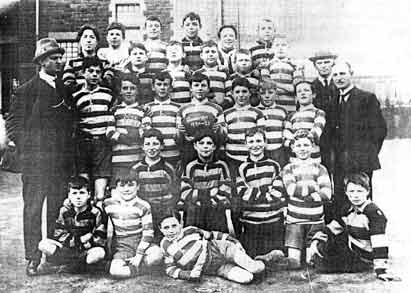
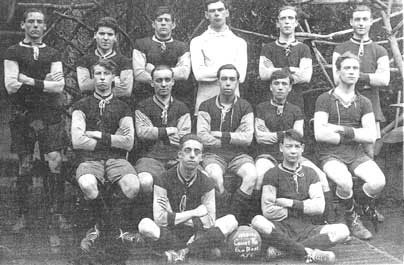
The turn of the 20th century saw more leisure time and a huge spurt in playing and watching sport. Here are just two of the many sporting teams in Grangetown at the time. From 1920-21 - the Court Road School rugby team and the Court Road School Old Boys football team.
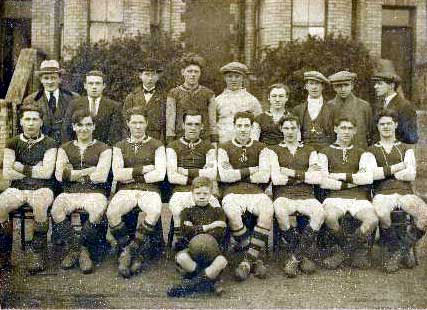
Grange Villa AFC, photo courtesy of Susan and Ken Powell
This photograph of Grange Villa AFC, in the
early 1930s, was sent in by Susan Rees, now Powell and living in Canada. Her grandfather
Albert Lloyd Rees, pictured front row, fourth from the left, was captain. Albert's
children still live in the area. The club's president was Mr Hold of the New Sea
Lock Hotel, a pub near the Docks and the team were probably stalwarts of the Marl.
The photo line-up appears to read: Back row: T Mann, J Smith
(committee), D Stewart, W Gape, T Evans, J Fish, K Leek, W Murrel (committee).
Front row: Gibbons (hon sec), A Extrom, G Sefrose, A L Rees, A Stevens,
A James, Peterson, Stokes and at the front S Griffiths, mascot. Let us know
if you are related to anyone here or can tell us more about the team.
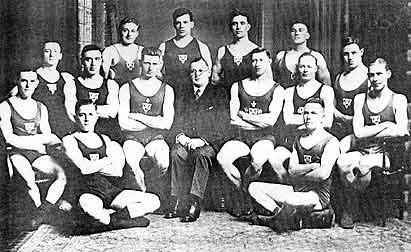
Another sporting team, this one the Grangetown YMCA Wrestling Club, who were winners of the Welsh championships in 1930 and this photo dates from the year later. The YMCA building still stands in Clydach Street. It became a day and community centre and is now an Islamic centre.

A hundred years of baseball
BY TONY HICKS
The 2007 season saw Grange Albion Baseball Club - the longest standing and
most successful club in Wales - celebrate its 100th birthday.
To commemorate this feat, a local schools tournament was on The Marl, which
was won by St Paul's. Then Grange Albion played a Combined Wales/England team
- a match which was drawn and later a centenary dinner was held.
Grange Albion baseball club came into being in 1907 by taking over the fixtures
of the disbanded Penarth Road Methodists team. The club's first league match
took place in May of that year away to Llandough in the 2nd Division of the
Welsh Baseball Association League. They won the 2nd Division in that first year
and have gone on to enjoy considerable success since.
The 1948 Dewar Shield winners - who were undefeated. Back Row - L Smith, A Lloyd, J Brimmell (Snr), H Dimond, D Spargo. Middle Row - D Lloyd, W Lewis, G Smith (Jnr), E Deakin, T Williams, L Smith, S Lloyd, J Brown, T Rose.
Front Row - D O'Leary, M Purchase, F Hayes, H Rowland, A Noyes, T O'Leary.
Also the line-up from the 1989 WBU Cup finalists. Back Row - Charlie
Kinsey, Dean Pesticcio, Chris Green, Haydn Mould, Gary Jones, John Jones. Front
Row - Anthony Roberts, Daren Young, Mark Jones, Stephen 'Spuda' Grainger, Geoff
Poole, Les 'Lula' Jeremy, Tony Hicks.
Indeed,
aside from being the longest serving team, Grange Albion are also the most successful
team in Welsh Baseball history with a record 28 premier league titles won. In
addition, the Club has supplied the Welsh national team with more players than
any other team.
In later years, the ladies team was formed and they too have had many successful
teams. Whilst the Club is rightly proud of its history, it is determined to
do all that it can to ensure that this great, amateur sport continues to have
a future and it is hoped that their centenary celebrations will help nurture
the next generation of boys and girls that will enjoy the game.
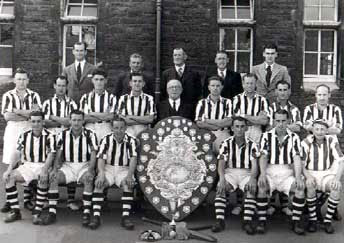
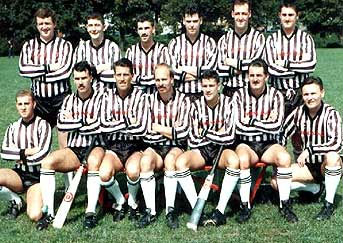
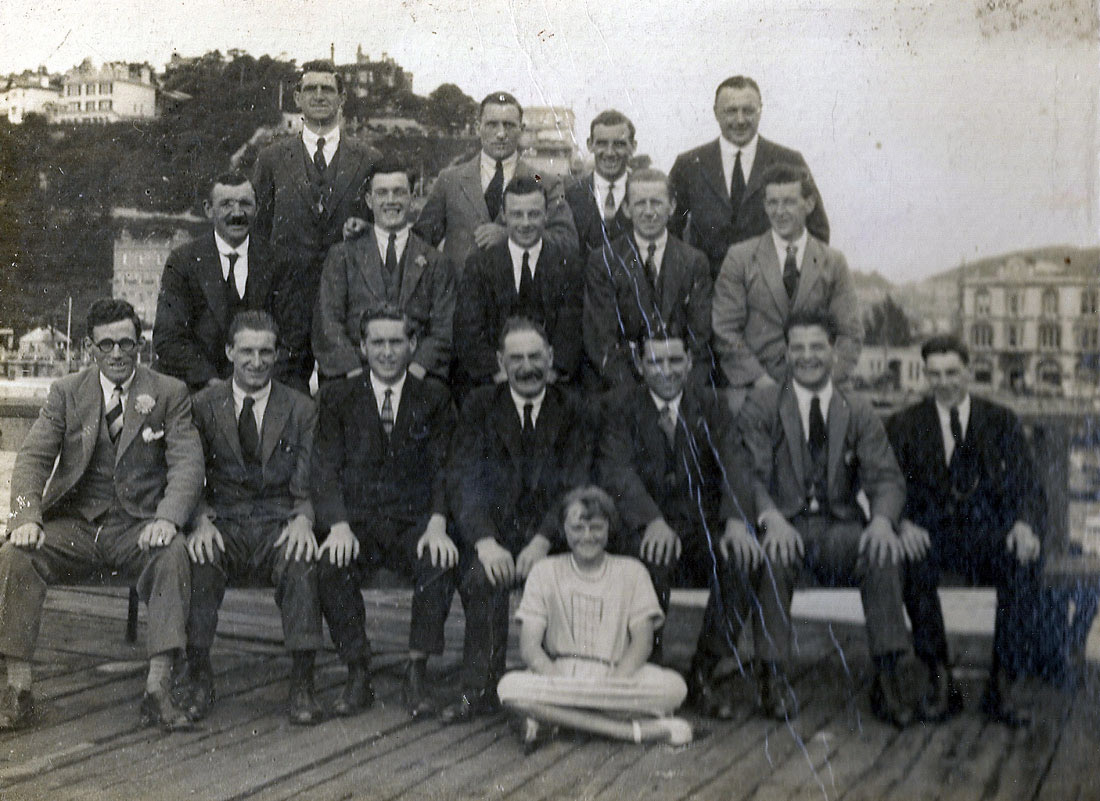
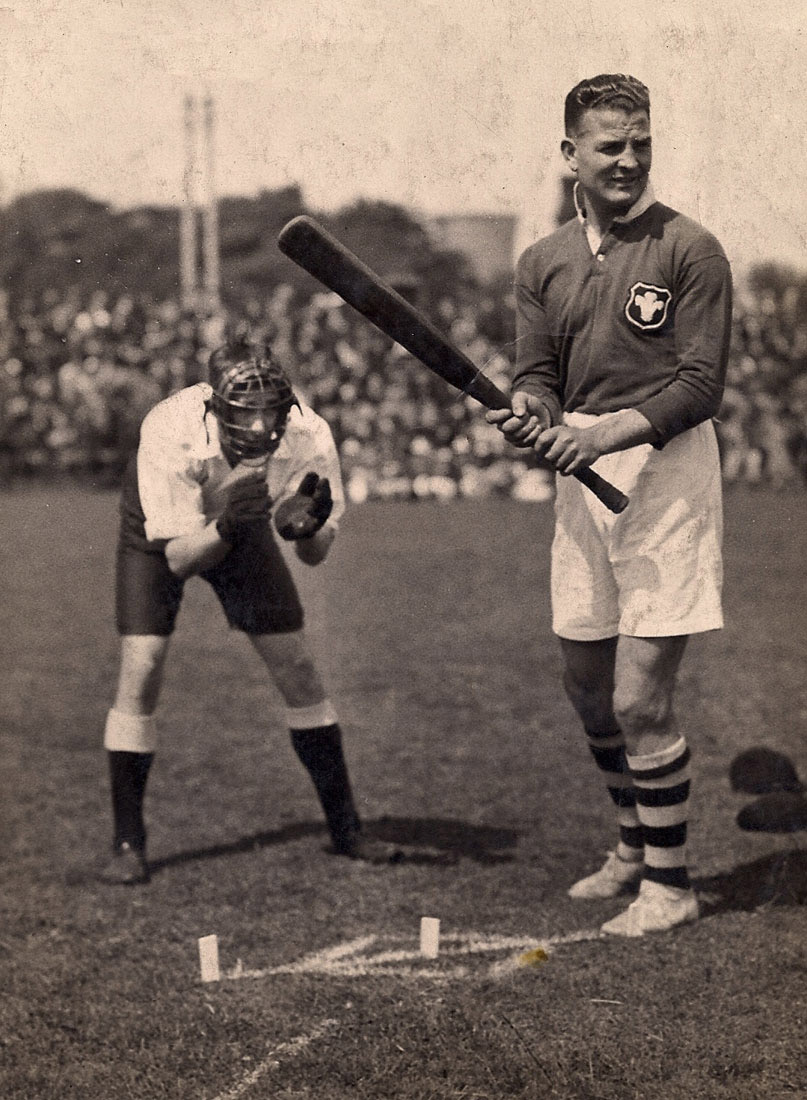
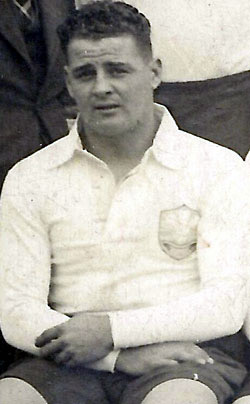
Frank Whitcombe (right) at the Welsh final trial 1935, which was a special
game to celebrate the Silver jubilee of King George the V at Cardiff Arms Park.
His brother George in action for Wales at baseball in 1931 (centre) and (left)
the Cardiff City squad in 1922-23, with George second right. Thanks to Martin
Whitcombe and David Lee
The 'genial giant' of rugby league and his footballing brother
Two sporting brothers from Grangetown went on to carve careers in rugby league and football in the north of England.
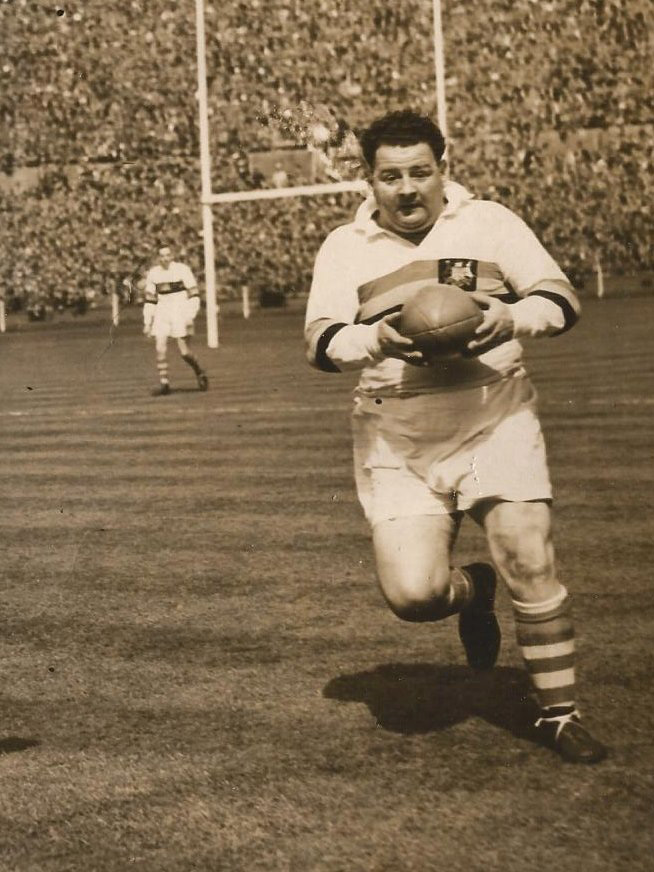
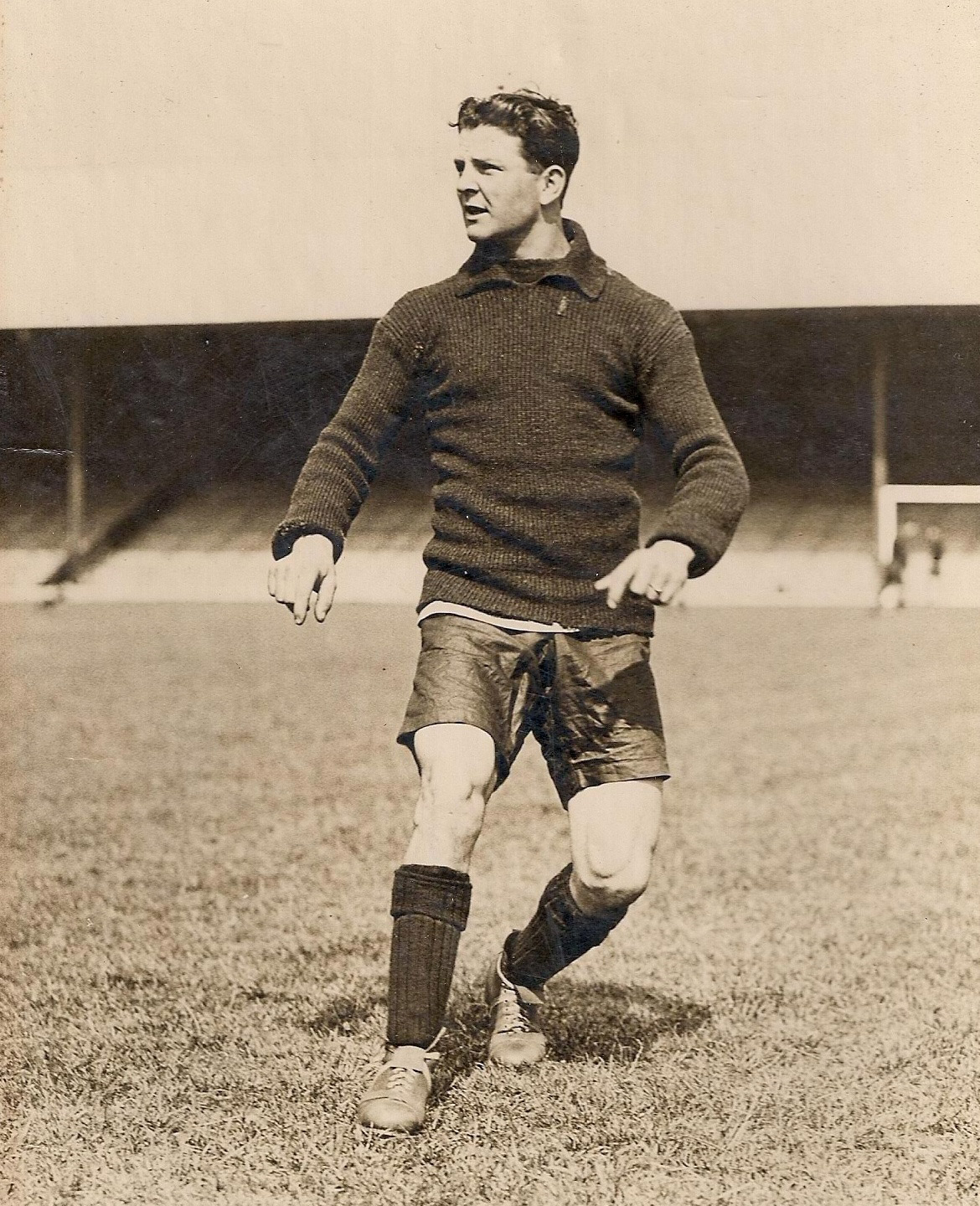
The Whitcombes were brought up at No 52 Wedmore Road. Frank and George were
two of 10 children born to metal worker Fred - also a prize-fighter in Cardiff
Docks - and his wife Gertrude. The boys attended Ninian Park Primary School
in Cardiff. Frank (1913-58) left school at 14 and worked for McNeils
The Coal and later as a van boy with the Great Western Railway. He had been
on Cardiff's books as a full back, and when he enlisted in the Royal Engineers
in the early 30s, he played rugby with Army. He became a professional rugby
league player in 1935 after a sparkling career for the Army side. He made more
than 450 appearences as a prop for Broughton Rangers and Bradford Northern,
where he was described in a programme as follows: "Genial giant Frank is the
wit as well as the heavyweight of the team. He turns the scales at over 18st.
And opposing forwards really know they have been in a game after 80 minutes
with him." He also won caps for Wales and Great Britain rugby league sides.
He appeared in three challenge cup finals at Wembley, including in 1948 when
before the match he took over driving the team bus after the driver got lost
in London - and was awarded the man of the match award, despite Bradford losing.
After retirement in 1949, he ran pubs before his death near Keighley in Yorkshire
in 1958 at the age of 44. His son Frank also became a rugby player for Bradford
and his grandson Martin for Leicester.
George (1902-1986) was, probably born when the family lived at 41 Stoughton
Street, later renamed Jubilee Street/Sussex Street) was a footballer and baseball
player. A right half and centre back, he started at Grange Albion in 1921, but
the following year signed for Cardiff City, who were in the First Division at
the time. "There was a lot of talent in the side in those days, including such
names as Billy Taylor, Jim Jones, Jack Nock and George Beere," George recalled
in 1965. George was transferred down a division to Stockport County, before
a dispute over a low wage offer saw him joining Port Vale, where he played more
than 50 times.. George ironically played against the mighty Arsenal in the semi-final
of the 1927 FA Cup, which the Gunners only won after a replay. They of course
lost in the final against George's home town club. His last league club was
Notts County but after a sending off for the only time in his career, and apart
from a player-coach role for a Cheshire league side, he decided to return home.
He also played baseball for the Albion, and also won five caps for Wales, as
well as captaining his country against England at a match played at his football
club Port Vale in 1930. He is pictured above in the 1931 Wales v England baseball
game at Liverpool. At the end of his playing career in 1930, George went home
to Cardiff, running the Lord Windsor pub in Grangetown, and later The Ninian
Park. He later ran The Coldstream Hotel in Riverside (renamed the Millers Tavern
and now closed) for 27 years until the mid 1960s. He died in 1986.
Thanks to Martin Whitcombe and Dave Lee for the photos and information.
If you have any stories of the Whitcombes as sportsmen or their time in Cardiff,
please let us know
Wales rugby captain and head teacher from Grangetown
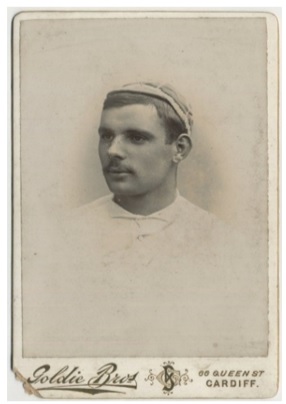
(Robert) Arthur Cornish (1897-1948)
Arthur Cornish was a Wales international rugby union player, who was born into a well-known rugby family, with his uncle Fred also playing for Wales.
He was brought up at 25 Pentrebane Street by his widowed mother; his father had been a seaman from the north east of England and Arthur followed him to sea with the Royal Navy during World War One.
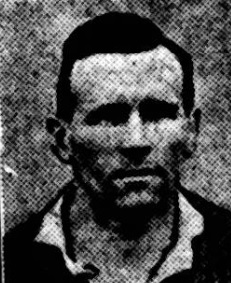 Arthur, a former pupil at Grangetown Council School and Canton Secondary School, played at centre and captained the Wales national rugby union team on two occasions in 1925–26. He also captained Cardiff from 1921 after recovering from a broken leg in the previous season. After retiring from international and club rugby, citing the "pressing nature" of studying for his job as school teacher, Arthur was a line judge and was chairman of the Wales selectors and remained involved in Cardiff Rugby Club as secretary until his sudden death.
Arthur, a former pupil at Grangetown Council School and Canton Secondary School, played at centre and captained the Wales national rugby union team on two occasions in 1925–26. He also captained Cardiff from 1921 after recovering from a broken leg in the previous season. After retiring from international and club rugby, citing the "pressing nature" of studying for his job as school teacher, Arthur was a line judge and was chairman of the Wales selectors and remained involved in Cardiff Rugby Club as secretary until his sudden death.
On leaving the national side, after winning 10 caps, he was described as a "sensation" in the Western Mail. He had made his debut against England at Twickenham in 1923, was known as a hard-running and elusive player who was adept at the "dummy."
He had been appointed head teacher of Ninian Park Junior school in Grangetown during World War Two and later Lansdowne Road Boys School but died after a heart attack at a friend's house in Llandaff in July 1948. It was the day after he had surprisingly failed to be re-elected as a member of the "big five" international selection committee.
Cornish Close, in Cardiff's Grangetown (where Arthur and his family were from), is named for Arthur and his four brothers, who were known locally for their contribution to rugby, baseball and cricket within the city.
Frederick Henry Cornish (1876-1940)
Arthur Cornish and his brothers were nephews of Fred Cornish who was born in Bridgewater in 1876. He was a boilermaker by trade and worked at Hill's Dry Dock and is first recorded playing rugby for his hometown club Bridgwater Albion.
He lived first in Penarth Road when the family moved to Wales and then in Ferry Road. Fred joined Grangetown Stars, but before the end of the season had joined Cardiff. During the 1896/97 season he was selected to play for the Welsh National team under the two-year residency ruling.
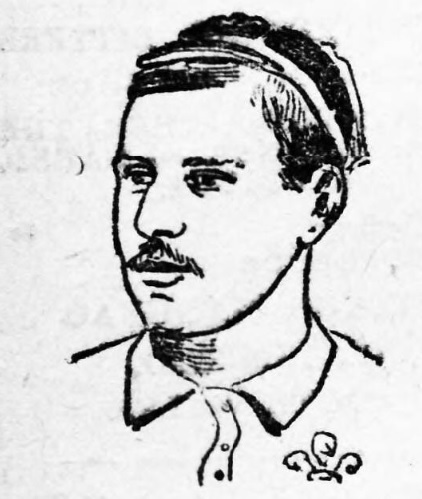
His Welsh debut came against England - he gained four Welsh caps in total.
The Western Mail described his elevation to the international team as follows: "Fred Cornish, while the youngest, is one of the heaviest members of his side. He is not yet out of his teens (or his apprenticeship to boiler-making), and his experience in first class football has been gained almost wholly this season, for it was only at the close of last season that he was drafted into the Cardiff premier team. Up to last season he played for the Grangetown Club. He is a native of a village near Bridgwater (Otterhampton). His promotion to chief honours has been fast, and it has been gained solely through sheer hard work and consistent training. Standing six feet clear, Cornish weighs in the buff four to five pounds over 13 stone, and he is no slouch on the field, his head-work being invariably sound, while he will not be surpassed in speed by many of the forwards at Newport. The strong points in his general play are his powerful scrummaging qualities, is tricky on the line-out and has a knack of fielding the ball such as is possessed by few scrummagers"
In the 1897/98 season Cornish was part of the Cardiff team that faced the touring Barbarians - Cardiff won the game 6-0 with Cornish scoring a try. In August 1899 he switched codes, joining Hull FC rugby league side.
Fred was also instrumental in getting the Grangetown war memorial erected, as vice chairman of the organising committee and also collected parcels to send out to prisoners of war from the city, also visiting hospitals and wounded soldiers.
FOOTBALL. Mr G. Nicholls's Cardiff Team v. Grangetown F.C. This match, which is creating a lot of interest, will be played on the Grangetown enclosure tomorrow evening (Wednesday) at 5.45 sharp. Cardiff : Back, W. Davies; three-quarter backs, E. G. Nicholls, V. Hussey, W. Jones, and A. M. Ricketts; half-backs, J. Driscoll and T. Savage; forwards, W. Phillips, T, Dobson, J. Blake, W. Bickford, M. Leary, E. Leary, C. Harding, and A. Owen. Grangetown : Back, T. Mabbs; three-quarter backs, F. Salmoni, W. James, H. Prole, and W. Flynn; half-backs, J. Hevens and W. Turnley; forwards, C. Harrison, T. McCarthy, F. Cornish, W. H. Coles, Radford, Buckley, R. Backman, and R. Maile. South Wales Echo, Tuesday, September 8th., 1896
Thanks to Terry Kane
David "Dai" Westacott (1882-1917) Dai Westacott, from Clive Street, was a Welsh international rugby union forward who played club rugby for Cardiff.
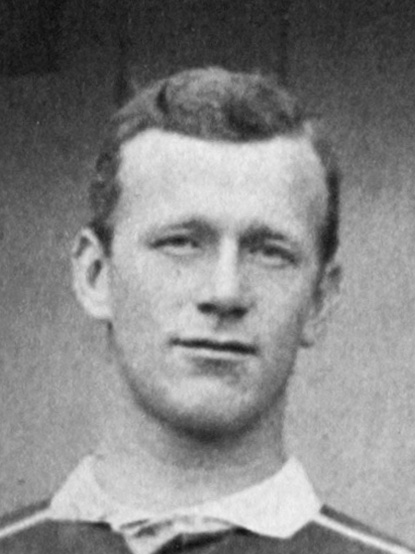 Westacott first came to note as a rugby player when he was selected for his school team, Grangetown National. In 1903 Westacott joined his city's premier rugby club, Cardiff. Westacott played seven seasons at Cardiff, turning out in 120 games for his club. In 1905 Westacott was selected for the Glamorgan county side to face the first touring New Zealand team.Famously, Wales had just beaten New Zealand. Westacott was one of five Cardiff players to join the Glamorgan squad, none had been part of the victorious Welsh team of five days earlier. New Zealand won 9–0. Despite turning out for Glamorgan on 21 December, Westacott was not part of the Cardiff side to face the tourists just five days later.
Westacott was selected for his one and only international cap for the Wales team in the 1906 Home Nations Championship. Wales lost to Ireland - Westacott was dropped for the next Wales international and never represented his country again.
He continued playing for Cardiff, and in 1908 played against the Australian tourists which resulted in the Australian's biggest loss of the tour, with Cardiff winning 24–8. Westacott continued to play for Cardiff until the 1909/10 season.
Dai volunteered at the start of World War One with the Gloucester Regiment and was wounded at the Somme in 1916. During the Third Battle of Ypres, on 28 August 1917, while in a support trench north-east of Ypres, Private David Westacott was tragically killed by shellfire.
Westacott first came to note as a rugby player when he was selected for his school team, Grangetown National. In 1903 Westacott joined his city's premier rugby club, Cardiff. Westacott played seven seasons at Cardiff, turning out in 120 games for his club. In 1905 Westacott was selected for the Glamorgan county side to face the first touring New Zealand team.Famously, Wales had just beaten New Zealand. Westacott was one of five Cardiff players to join the Glamorgan squad, none had been part of the victorious Welsh team of five days earlier. New Zealand won 9–0. Despite turning out for Glamorgan on 21 December, Westacott was not part of the Cardiff side to face the tourists just five days later.
Westacott was selected for his one and only international cap for the Wales team in the 1906 Home Nations Championship. Wales lost to Ireland - Westacott was dropped for the next Wales international and never represented his country again.
He continued playing for Cardiff, and in 1908 played against the Australian tourists which resulted in the Australian's biggest loss of the tour, with Cardiff winning 24–8. Westacott continued to play for Cardiff until the 1909/10 season.
Dai volunteered at the start of World War One with the Gloucester Regiment and was wounded at the Somme in 1916. During the Third Battle of Ypres, on 28 August 1917, while in a support trench north-east of Ypres, Private David Westacott was tragically killed by shellfire.
You can read more about Dai Westacott on our World War One memorial project website
Boxing in the shadow of War - and the gasworks
BY JACK PAYNE
Cardiff Gas Boxing Club was located pre war and during the 1940s in the
cricket pavilion of the sports field of Grangetown Gas Works in Ferry Road,
Grangetown Cardiff.
Prior to going to Howard Gardens High School, I attended Grangetown National
School, Clive Street, Grangetown, and our family were then living at 81 South
Clive Street.
When I was nine years
of age, 1942, Tommy Bewley who was in the same school and lived at the lower
end of South Clive Street, told me that he and his younger brother Leon had
joined Cardiff Gas Boxing Club. He told me that Mr Fearnley who lived a few
doors away from him ran the club. He suggested that I join the club with him.
Since the outbreak of the war the Gas Works and the sports field had been
closed to members of the public and I think the prospect of being able to go
through the Gas Works to the sports field held as much interest to me as joining
the boxing club so I agreed to go with Tommy and Leon to the club.
Although the black-out was in being I think it was late Spring or early Summer
and we then had double summer time which meant it didn’t get dark until about
11.30pm, so initially I was going and coming home whilst it was still light.
When I first arrived at the Boxing Club I saw that it was in a wooden pavilion
on the far side of the sports field from the Gas Works.
The club had two trainers Mr Fearnley and Mr Bannister who had a son Roger
who was a member. Roger was then about 16 years of age. There was about six
other lads members of the club whose ages ranged from about 14 to 17 years of
age. They were all from the upper Grangetown area. Only Tommy, Leon and I were
from lower Grangetown.
There were no lads over the age of 17 because at 18 years they were recruited
into the armed services. Leon was about the same age as me. We were the two
youngest in the club and I think Tommy had asked me to join so that I could
be a companion for his younger brother. The club night then was once a week
on a Wednesday. I had nothing special to do in the evenings so I joined the
club. Two former members of the club Cyril Galley and Jackie Pottinger, now
in the forces and former A.B.A. champions, were heroes of the club and persons
whom we could look up to as good examples.
The equipment in the club was very sparse. The boxing ring took up nearly all
the centre part of the pavilion. There were two punch bags consisting of two
canvas kit bags filled tightly with old rags and sand. They were suspended on
ropes from the rafters. There was a punch ball fixed in one corner but its height
was such that the bottom of the ball was about level with the top of my head.
There were a number of skipping ropes, two sets of tapered juggling sticks
and sets of boxing gloves in sizes 8oz, 12oz and 16 oz. When I arrived on the
first evening I was told that before I was taught to box I had to get fit and
to do this I had to run around the perimeter of the sports field a few times
followed by a period of skipping and then juggling with the juggling sticks.
These sticks were intended to improve dexterity and quickness of your arms and
hands. I think I spent more time picking them up from the floor having dropped
them.
I was already a very fit young boy when I joined the club but I think Leon
and I were told to do this so that more concentration could be given to the
older lads who were spending more time sparring in the ring. This process of
running around the sports field, skipping and juggling continued for some weeks,
but I was allowed to have a go on the punch bags. The older lads had punch bag
gloves but I used bare fists. I soon found that the hard canvas took the skin
off my knuckles.
There was no way I was going to be able to afford proper gloves so I used
my socks on my hands this helped a bit. Later I got an old pair of ordinary
leather gloves and used them until I was 18 years of age. Eventually the time
came when I started to get instruction on how to box.
I had been told to watch the older boys when they were sparring so that I
could see the way they used their feet, body and hands. There was then a discussion
whether I was to be an orthodox boxer or a southpaw. It was decided I should
be orthodox and there followed a period where I was instructed in shadow boxing
outside of the ring learning to lead with my left hand and to move around with
my left foot in front of my right. I had been at the club some months now and
had still not gone into the boxing ring to spar.
I remember when I first put on a pair of the boxing gloves. They smelled
strongly of stale sweat, and when you put your hand inside the lining most of
the gloves was broken and the horsehair padding would be all around your fingers.
The state of the gloves wasn’t unique to our club. I found later when visiting
other clubs for tournaments their gloves were in a similar state. Sometimes
you could push away the padding from around your knuckles so that a thin layer
of worn leather only covered your fist.
The time came when I was allowed in the ring. I didn’t have any boxing boots
or daps (they are now called plimsolls) so I went in stocking feet. I didn’t
spar with any of the other lads only a trainer who either invited me to punch
at his hands or at a punchboard which was something like a padded stool. This
very gradual introduction was fine as far as I was concerned I was learning
the art without suffering the pain of being punched on the nose. It also allowed
the trainers to concentrate more on the older boys who were entering contests
and relieve them of the concern as to who they should allow me to spar with.
The months had passed it was now autumn the nights had drawn in the black-out
was in force and it was pitch dark walking through the streets and through the
Gas Works. The club nights continued I think Leon had given up but as I was
now getting more training I decided to continue. On my way home I always ran
along the centre of the road just in case there was anyone there out to get
me.
It was either late 1942 or early 1943 that I made my first public appearance
as a boxer! Two of the hospitals in Cardiff, Rookwood and Whitchurch had large
numbers of servicemen wounded in the war receiving treatment and convalescence.
A decision was made by the organisers of our club and the Melingrifith Club
in Splott Cardiff to put on a boxing show for these servicemen, using boxers
from both clubs. The evening arrived and off I went with the other members of
our club to Rookwood Hospital. When we arrived they set about making a ring
in the centre of one of the wards by using chairs with their seats facing outwards.
The wounded soldiers were all around some in beds and some sat on chairs.
There were a few contests between the older lads of our club with those of
the Melingrifith Club and then came the finale of the evening with the younger
lads. I was still the only young boy in our club but the Melingrifith Club had
three young boys of my age. All four of us boys went into the ring together
one in each corner.
We were then fitted with 16oz gloves, which in my case came right up to my
elbow. We were then blindfolded by having a scarf tied around our heads. At
the sound of the bell the trainer for each boy twisted the boy around as fast
as he could for three or four times until he came giddy then pushed him out
towards the centre of the ring with the instructions punch as much as you can.
There was ructions, boys very giddy were falling down, tripping over chairs,
punching wildly into space occasionally connecting with someone in front or
someone from behind and all the time the soldiers and nursing staff shouting
out watch out he’s behind you or he’s in front of you! It was pandemonium, we
had three two minute rounds of this but nobody got hurt, and it was obvious
that everyone enjoyed the evening. We put on a similar event at Whitchurch Hospital
later in the year and that was also a success.
Although the club was having the occasional contest with other clubs in and
around Cardiff at that time I was not being entered in any contests. There was
a rule, whether it was an official one established by the WABA or by some other
body I don’t know, but it required boys entering contests to weigh at least
5 stones. I was under five stones, and the events at Rookwood and Whitchurch
were not regarded as contests.
During this period there was another Boxing Club in Grangetown called Cardiff
Amateurs. I don’t know why but it may have been something to do with one club
enticing boxers away from the other, but there seemed to be some bad feeling
between the persons who ran the clubs. It was noticeable that whereas we had
frequent contests with other boxing xlubs in the Cardiff area we never had one
with Cardiff Amateurs. At this time Cardiff Amateurs were more successful than
our club having a number of Welsh and ABA champions. Most of the boxers of Cardiff
Amateurs came from the dock area with a number of Afro-Caribbean and Asian boys.
For the rest of the war years the club continued to operate from the Gas Works
Field.
Then about 1946 or 1947 the club moved to the old air raid wardens' post and
incident centre building on the edge of The Marl near Channel View. This was
a more substantial building made of brick but the rooms were not very large.
The boxing ring took up nearly all the floor space in the room it was in,
just leaving about two feet of space around each side. There was one room there
which was long and narrow and a man named Cyril Guy whom I think was also a
trainer at Cardiff City Football Club came to the club and started a gymnastics
class. A vaulting horse was installed in the long room and both boys and girls
joined the club some interested in the boxing and some just in the gymnastics.
The gymnastics class became quite successful and at least one girl was chosen
to represent Wales in the Commonwealth Games. I think her surname was Lewis.
However numbers in the boxing club began to dwindle with no new members joining
from Grangetown. We had by that time had a few contests with clubs in the Welsh
valleys and from this we recruited some boys from Nelson and nearby towns. One
of the boys Albert Davies became very successful as did Dai Dower who also joined
the club. By 1949 I had won some Welsh schoolboy titles and Welsh Youth Club
title and runner up on other occasions.
Billy Manning had joined the club by this time as a trainer, his method of
training slightly more aggressive that the other trainers. Billy could see that
he had two very promising fighters in Albert Davies and Dai Dower . There was
also another from Nelson but I have forgotten his name. I think that Billy could
see that he had good prospects here for professional boxers.
My own interest in boxing was waning somewhat because I had discovered girls
were quite interesting. We had started to have some professional boxers come
to the club to train and Cyril Galley and Jackie Pottinger came to the club
but did not take any great part. Whether it was because of Billy’s concentration
on the boys from the valleys or because we were not recruiting lads from lower
Grangetown but a decision was made to move the club to North Clive Street. This
move split the club with some staying at The Marl and others moving to North
Clive Street. I stayed at The Marl because it was just around the corner from
where I lived.
Subsequently Billy Manning who initially stayed at the Marl left with Dai
Dower and some others to set up his own Boxing Club in Splott. The move to North
Clive Street had had the desired effect of recruiting more lads of whom a number
went on to win both Welsh and ABA titles. I rejoined Cardiff Gas Club at North
Clive Street in 1949 where I remained until I was called for National Service
in 1951.
Dennis Courtney, now living in South Australia, writes: The person
who ran the gymnastics at the Marl was Cecil Guy, and he used to instruct the
Cubs from the Baptist Church - 52 Cub group - in vaulting and general fitness
as well. We had a couple of older lads who played football come and train with
us, I can't recall their surnames, but they were Nick, Phil and Tommy who used
to go to uni and was a sprinter. The gymnast mentioned was Gwyneth Lewis. Mr
Guy at the time lived in Clive St and later moved to Llanmeas St. I used to
go to the Grange Council School with his son Glyn and am still in contact with
him. I used to go to a boxing club but I am sure now whether it was in Earl
St or Amherst St lane. Tommy Plumbley who lived near us in Cambridge Street
got me interested in it. I didn't stay there long as they were more interested
in the older boys and we were left to or own devices.I remember in the summer
Vera Francis who took the cubs, would give us a treat and we would all march
from the church down to the Gasworks field to play cricket. Also on a Friday
evening I would take our dues to the church and pay The Sons of Temperance.
It used to be the fore runner of the health service. I used to go to the Ebenezer
Gospel Hall in Corporation Rd and one of my Sunday School teachers Mr Elliott
was collecting so it must have been a combined church insurance type thing. (William) Albert Love (1911-1943)
But by the summer of 1920, the post-war "attendances of the general public has not been of the best" for the prize athletics and whippet races. Then the promoters put up what was claimed to be Wales' biggest prize for a whippet race, £50. The promoters found the races popular with competitors and owners, but not enough with spectators. By Ken Payne In the winter on cold evenings, bedding would be supplemented with the
family overcoats. A replacement for a hot water bottle would be a brick
warmed in the stove and wrapped in a towel. The other more risky option
was to fill a pop bottle with hot water and clip it down and hope it didn’t
leak. Money was always tight, but to my memory we were always well fed, albeit
with a surfeit of staple food stuff - potatoes, cabbage, bread, etc. There was
no such thing as sell by dates, so everything that was bought was consumed
in one way or another. Also there were no refridgerators in those days, only
a cold slab in the pantry. Consequently the family shopped every day for
fresh food. Living in Grangetown in those days was certainly an adventurous
place for a young boy with spirit. On the one side we had the Marl playing
fields, with beyond that the Tide fields. This was like a magnet to us as
young boys. We would spend hours on the foreshore between Bowles sand wharf
and the old Windsor pier. Then at the bottom of our street was the BRS
Depot (British Road Services). You could walk down the side of the depot
and out on to Ferry Road. Alternatively you could go through the BRS car
park and come out on the little "beach" before the Red House Pub. This
beach was no more than a bit of shingle, but I saw people stretched out
sunbathing as if they were somewhere exotic.
I mention in the section above about the River Ely subway and retrieving
scrap metal from Penarth docks. Another money-maker as a gang of boys
would be to go blackberry picking. We would collect them in jars, tins
or bowls, then they would all be put in one big box, and taken to Chivers
jam factory on Ely Bridge. This was quite a messy operation. Very often
juice would run out of the box all over bus seats and us. However I remember
getting a nice crisp tenbob note for our troubles, which probably worked
out at a shilling each! When we were involved in group activities like
this the money would be used to buy something we would all use. Cricket
was a great pastime for us boys then, so we would buy a new ball or batting
gloves and even one set of pads. A nominated boy would mind the gear and
would always seem to be available when we played. It would be no problem
to gather up to 14 to 15 boys for impromptu games. You would have 11 fielding,
two batting, with one pad each, and one or two umpires. All the scores
were individual you batted until out, then you would rotate for someone
else to bat until you went through the entire group, top score obviously
being the winner. The keen cricketers were Alec Leach, Dai Preece, Les
Lawson, Mike Smith Phillips, Glyn Thomas, Robert Jones, Haydn Brown, John
Hill, David Thomas, David Charles Thomas and several others.
We got rather
a good side together and played “Test” matches against the Caribbean All
Stars the forerunner of the CIACS club. We also formed our own soccer
team with a lot of this group of boys. The first kit for our team, Grange
Athletic, was a white T-shirt, white shorts and white socks. We fancied ourselves
as Real Madrid. Our first game was away to Taffs Well. I can still remember
working out how we were going to get there by bus. We ended up walking
the last mile or so. Unfortunately we lost that first game 5-3, but I managed
to score twice with another lad Terry Smith getting the other. That was
the start of a very good side that went on to win the league and cup in
the next two years. Most of that side went on to play for Grange Harlequins, where
we had many successful seasons. Thinking back to those days life consisted
of school, play (mostly play) and ways to earn some pocket money. One of
our favourite ways was collecting bottles. We were experts on the return
value of beer and pop bottles.These would vary in return value of between
2d-4d (two or four old pence) A lot of the bottles were franked with a
system of little slits in the bottom of the label. If there was difficulty
in returning bottles to the "offy" or local sweet shop we would endeavour
to copy these slits to get them accepted. Any bottles that were unreturnable
were taken to the "Point" at high tide and thrown in. We then proceded to
throw stones at them until smashed or until the current took them out
of range. Another money earner was Christmas caroling, where basically we
were paid to away. Penny for the Guy was our means of buying fireworks. There
were a few choice locations to site the Guy. The bus stop on Channel View
and Beechers Avenue was our favourite, catching the people going to the
B.R.S or coming home from town. There didn’t seem to be any age restriction
then on purchasing fireworks, we could buy bangers, rockets, Catherine wheels, Roman
candles and other types. These would then be set off at the huge communial
bonfire on the Marl. I regularly run errands for elderly neighbours for
two or three pence. Another regular haunt was over by Bowles wall by the
sand pit. This is where a large gathering of men, maybe 25 to
30 would congregate to play pitch and toss, an illegal betting assembly. Very
often we would pick up coins after they had gone, or there had been a warning
of a raid. Some of the boys had regular pocket money, two bob or half a
crown. Most of my mates didn’t, hence our money-making schemes. I was spoilt
in some ways though. I used to get comics bought every day - Knockout, Beezer
Wizard, Hotspur and so on. On occasions I would be kept home from school
to do the shopping. Poppys on the square for fruit and veg, Bob's the butcher
for meat, Tarvers for groceries, Brutons for bread and cakes, Williams for
newspapers magazines and comics. Once the shopping was done it would be
“elevenses” - a feast of bread rolls and cakes whilst reading my comics.
I would then be sent to school in the afternoon with a note for teacher
feigning some sickness or other. We were very wary of the boardy man in
those days, used as a threat if we misbehaved. The boardy man being the
truant officer who would whisk you away to boarding school if caught. These
are just a few of the activities that most boys of my age took part in. A
very happy and eventful place for me to spend my formative years.
MEMORIES OF THE MARL AND BASEBALL AND LOCAL FOOTBALL
By Ken Payne I will begin with the Marl playing fields in Grangetown. Some of my earliest
sporting memories are of baseball games on the Marl. The local team of that
era were Grange Stars, with the majority of the team made up of men from Ferry
Road, Holmesdale Street, Earl Street and Channel View. The team was probably
run from The Plymouth, with eventually a Grange Stars club opening on the Square.The
weather for games always seemed to be fine,and you would get big crowds attending
the matches.Evening games were a big attraction,knock off would be around 6.30pm
with many games lasting till 9.30pm or later. Organisers of the teams would
go amongst the crowd with a bucket to collect donations to the club. The children
(including me) would chase in and out of the crowd playing tag or hide and seek.
Other teams of that era that stick in my memory were "Ever Open Eye", I was
always fascinated by that team's name. Splott U.S. were another though I never
knew what the U.S stood for. Alexander Old Boys from Newport, to my way of thinking
then I expected a team of old men. There was also of course the mighty Grange
Albion the most successful side in baseball history. That team boasted some Grangetown
legends, Mac Purchase, Don O'Leary, John Roberts, Georgie Morris and Maurice Jones
to name a few. We were amazed at the skill of these local men. You had several
expert positions, backstop being one of the most skilful.Then you had first base
a specialist position.Third base was also a tactical position. Then of course
you had the bowlers who could leave you bewildered by their speed and accuracy. There
were some exceptional bowlers but the most famous has to be Paddy Hennessey, renowned
for his speed. The batting side also had its specialists: men who could cut
over the slips, punch the ball over one base, slog over base three or just drop
the ball at their feet and scamper to base one. You also had the caller in the
"box",who would prompt the men on the bases. He would tell them when to make
a dash for the next base,or after the ball was struck how far he thought you
could get around the bases. A good caller could earn your side valuable runs,a
poor caller could lose your team a few batsmen.
Other baseball sides based in Grangetown were the Catholic Club,a very good
young side. The Lyndon Club with a mixture of old and young players.Then there
were the football-based sides who played baseball in the summer to keep the
team spirit. St Patricks, Grange Quins and Grange FC fell into this category,but
they were also quite successful as baseball sides. Sevenoaks Park, or the Tan
as most locals called it was the home to Grange Albion,where you could get big
crowds. However you might find two other matches being played on adjoining diamonds
at the same time. This always gave the option of watching a few games for your
Saturday entertainment. There was also a thriving ladies league, with Grange
Albion ladies being one of the best sides in Cardiff. Baseball in school was
also very popular,with school leagues and cup competitions giving youngsters
plenty of scope to play organised games. I look at the sports at local and school
level today and regret the decline in these sporting activities.I am sure they
made for a stronger community and gave a sense of pride and belonging in your
particular area.
I would also like to comment on the local soccer scene in this era,late fifties
through the sixties. Grangetown in this period had the most successful side
playing in local league football. St Patricks of the Cardiff and District league
won the first division for approximately 10 consecutive seasons. They steam-rollered
most of the opposition during this period and were a great local team.The two
other long surviving clubs are Grange Albion and Grnge Quins.Grange Albion was
an institution in Grangetown and had strong local support.The football side
never quite reached the achievements of the baseball side however. Grange Quins
formed in 1935,came to prominance in the mid sixties.They began to rival St
Pats at this time, and eventually became the biggest club in Grangetown.They
became the only Grangetown side to play in the top division of the Welsh League.
There were other teams from Grangetown at this time, most of the teams made
up from local men and youths.Grange FC started in the lower leagues and went
right through to the first division .Inter Grange was a team of local youngsters
from the Clive Street and Penarth Road area that had a successful team. Grange
Nomads was a team run from the youth club off Corporation Road.Grangetown Torchbearers
was the Salvation Army side run from their base in Amherst Street.
There were several youth teams as well,Grange Athletic in the early sixties
winning league and cup. St Pats youth and Grange Quins youth having an intense
rivalry were two terrific teams.there was also a North Clive Street youth side
as well. Some of the clubs were running several sides,Grange Quins were running
three mens teams and a youth team.St Pats two mens teams and a youth team Grange
Albion two mens teams and Grange FC two men's teams. Most of the other clubs
just ran the one side. At this time, mid sixties, there was probably 12 men's
teams and three youth sides being organised by Grangetown-based clubs,utilising
mainly Grangetown-based players.
Behind the clubs I have mentioned were the men or
commitees that made it possible. Each club had its men who gave their time and
energy to the benefit of the club.St Pats had George Pooley who seemed able
to bring in players to maintain their success during their period of dominance.Grange
Albion had their stalwarts who worked csuccessfully at soccer and baseball.Grange
Quins teams were selected by committee at this period,they would meet every
Saturday after the game and select the team for the following game.
However Bert Smith Phillips and his sons Les and Michael put huge efforts into
the success of the club. John Lynch was resposible for the setting up and ultimate
success of Grange FC.Originally run from the Drake & Lynch betting shops and
later from his newsagents in Corporation Road. All the clubs I have mentioned
have certain individuals that took it open themselves to do something for their
local community. The starting up of new soccer teams seems a thing of the past,
I can only say that I was glad that these clubs were around to give me the opportunity
to play on a regular basis. I hope others will comment on these times and perhaps
put forward some more facts or opinions.
Before PlayStation or play areas, the
games played down our street
The proliferation of the motor vehicle in the years after World War II
had a marked significance on the games children once played in the streets of
our cities, writes Jack Payne. Sports fields and play areas were non
existent in Grangetown with the exception of Ninian Park so children used the
roads, pavements and wall of houses to pursue sporting and other physical activities.
Designated play areas of today do not have the space required for many of
these games which have now faded into history with the exception of football
and cricket. Children playing these games numbered maybe six to a dozen was
also entertainment for many parents who would stand for long periods at their
doors and gates watching these activities.
The following list is not exhaustive - there was also hide-and-seek, hop-scotch,
statues and conkers. Some readers may remember others:
RELEASTER OR KICK THE TIN A space was chalked on the pavement about six
feet wide and either a child or a tin was placed in this area guarded by another
child. The object then was for other children to run into the guarded area and
kick out the tin of pull out the child without being caught. If caught they
would join the guard.
HECKY A child would be selected to stand in the middle of the road
hopping on one leg. The remainder would line up on the pavement and try to hop
across the road being prevented by the one in the middle who tried to knock
them over. Anyone who put their other foot down joined the guard in the middle
until only one (the winner) was left.
QUEENIE O CO CO. Played with a ball thrown back over the shoulder
and having to guess who is holding it behind their back MAY I CROSS THE ROAD
MR. Completed by doing dwarf, scissor, or giant steps called by the child in
the middle of the road
SOOT OR ASH BOMBS Two teams were selected and each given a short period
to make as many as they could of soot or ash bombs. Most gardens in those days
had a pile of soot or ash neutralising in the garden before being added to the
garden soil. Bombs were made by placing a handful of soot or ash into a sheet
of newspaper folding the corners together and tying with a length of string.
The two teams would then set up opposite each other in the road with a space
of about twenty yards intervening. At the shout of go each person would twirl
their bomb as fast as they could before letting it fly in the direction of their
opponents. The object would be to catch the bomb before it hit you or landed
in the road exploding and return it.
TENSIES Played with a tennis ball against the wall of a house
MARBLES Three different versions.In
the ring.In the hole, and In the gutter.
SKIPPING Either individually, or by stretching a long rope across the
road and three or four skipping together or running in and out skipping.
WALL WALKING.The wrought iron gates and railings
on top of the garden walls were removed for the war effort. The object was to
walk in opposing directions along the top of the walls and jump the intervening
gate spaces and pass each other without falling off. RACING. Straight forward
racing, relay racing, racing on stilts made either from blocks of wood nailed
to a pole or by using tins held on to your shoe by strings. By using bogeys
made from a plank of wood and pram wheels. Steering was generally made by using
string attached to the front axle, but some went to great lengths to fit other
methods of steering. Car tyres were also used for racing, with one child curled
up inside the tyre and propelled along be another.
FARMER WANTS A WIFE Child. Dog. Bone. We all pat the bone.
POKE THE PIG The pig was either a leather football or a large ball
made out of old rags and paper tied with string. Two teams were selected wiyh
a goal and each child having a broom handle or something similar. The object
then was to poke the ball along and score a goal.You were not allowed to strike
the ball only poke it.
RAT TAT GINGER. Knocking on doors and hiding when they answered. Usually played
after dark. (Not recommended, or encouraged in these days of Asbos)
FLICK THE CARD Most cigarette packets contained cigarette cards featuring
sporting idols, cars, ships, film stars, flowers, animals, and other features.
Some were very collectable and could be obtained by swapsies or by playing flick
the card. One flicked a card towards one of your choice. If you landed on that
card it was yours if not your card remained there.
Just think of todays health and safety issues amongst those games mentioned
above! © Grangetown Community Action/Grangetown History Society
and webmaster 2022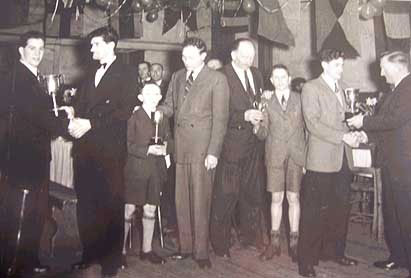
A presentation evening at Cardiff Gas Boxing Club, in St Barnabas Church Hall,
North Clive Street December 1949. As you look at the picture Jack Payne is receiving
the cup on the far left. George Bale is receiving the cup on the far right.
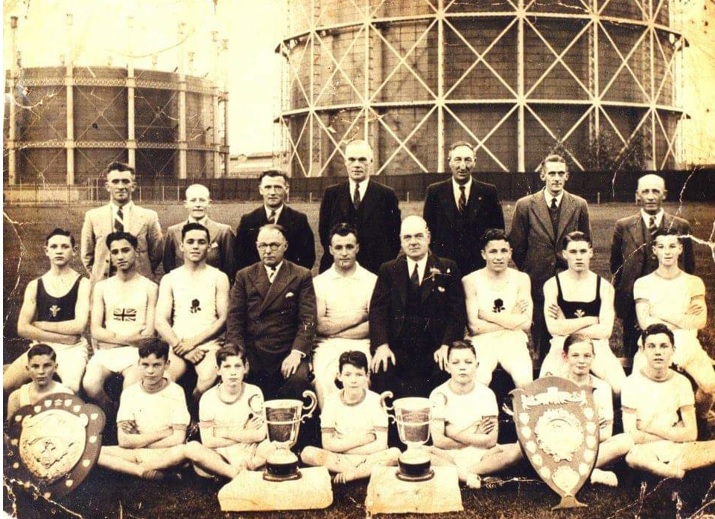
Cardiff Gas Amateur Boxing Club c. 1938 (Copyright Rob Dumazel)
Cyril Gallie (1920-1995) (third from right, centre row) of 16 Devon Street, was a boxer - trained at the club by his brother Alf - described in 1938 at the Welsh amateur championships as the "finest boxer that Wales has turned out for many years," with "lightning two-handed attacks" which left his opponent in the final "a sorry mess." Gallie, who worked in a film processing laboratory and became a sergeant during the war, went on to fight professionally at featherweight and welterweight between 1944 and 1948. He also boxed in USA.
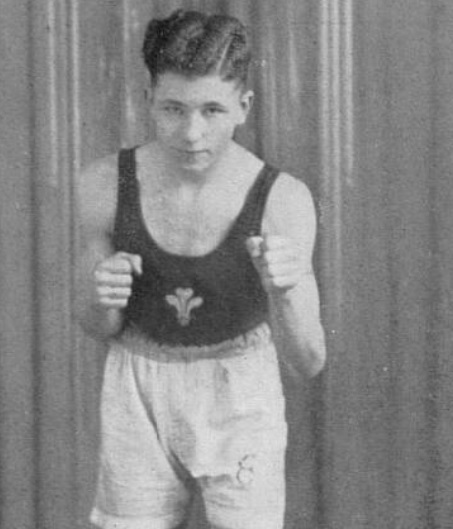 Cyril was ABA National Featherweight Champion 1938 and 1939.
Edwin "Eddie" Dumazel (1923-2003) (second from left, centre row) boxed professionally at featherweight and had been the Welsh and British champion in 1940. Father: Maris F I E Dumazel; Mother: Annie Price m. Dec, 1922, Cardiff. Lived at 45 Somerset Street, Grangetown. Flew to New York in November, 1947 for a boxing match – returned in May, 1948 on the Queen Elizabeth. In 1949, a tour of America resulted in 11 victories in 12 fights. He later became a boxing manager.
Cyril was ABA National Featherweight Champion 1938 and 1939.
Edwin "Eddie" Dumazel (1923-2003) (second from left, centre row) boxed professionally at featherweight and had been the Welsh and British champion in 1940. Father: Maris F I E Dumazel; Mother: Annie Price m. Dec, 1922, Cardiff. Lived at 45 Somerset Street, Grangetown. Flew to New York in November, 1947 for a boxing match – returned in May, 1948 on the Queen Elizabeth. In 1949, a tour of America resulted in 11 victories in 12 fights. He later became a boxing manager.
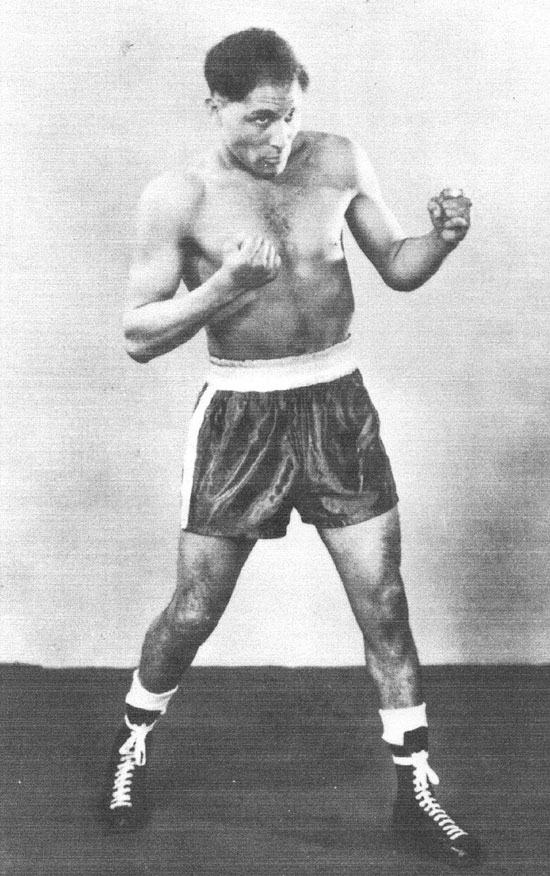 He had previously won the Welsh and British ABA titles as an amateur in 1953. In 1960, his victory over Billy "Spider" Kelly at Sophia Gardens in a title eliminator gave him a crack at the British light-weight title. But he faced a frustrating year for his chance. When he eventually faced champion Dave Charnley at Nottingham Ice Rink it ended all too quickly - inside 40 seconds of the first round, which was then a British record.
The young Hughes took up boxing as a schoolboy, after being bullied. He was born in April 1930 in Herbert Street in Butetown to a Trinidad-born father, a sailor, who died in 1942 when his ship was torpedoed. The young David went to St Mary's school and fought at the central youth club and by the age of 15 was the Welsh and British Army Cadet champion.
He had previously won the Welsh and British ABA titles as an amateur in 1953. In 1960, his victory over Billy "Spider" Kelly at Sophia Gardens in a title eliminator gave him a crack at the British light-weight title. But he faced a frustrating year for his chance. When he eventually faced champion Dave Charnley at Nottingham Ice Rink it ended all too quickly - inside 40 seconds of the first round, which was then a British record.
The young Hughes took up boxing as a schoolboy, after being bullied. He was born in April 1930 in Herbert Street in Butetown to a Trinidad-born father, a sailor, who died in 1942 when his ship was torpedoed. The young David went to St Mary's school and fought at the central youth club and by the age of 15 was the Welsh and British Army Cadet champion.
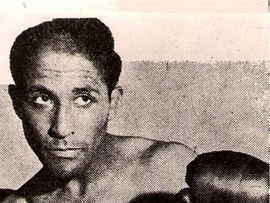 After turning pro, he fought Willie Lloyd for the vacant Welsh lightweight title at Maindy Stadium. Boxing historian Gareth Jones, in his The Boxers of Cardiff wrote: "A hand injury hampered Hughes but there were still many who thought refereee Joe Morgan wrong in giving the decision to Lloyd."
Of that all too sudden ending to his British title hopes in 1961, Jones added: "A southpaw right hook staggered the drawn-looking challenger in the opening seconds, another sent him to his haunches and when he rose, a third sent Hughes crashing in his own corner, his head bouncing off the canvas."
Although he gave up boxing a few years later, Hughes remained interested in the sport and was a leading light in the establishment of a boxers' union in Wales. Outside the ring, working life included time as a boilerman and took him from Wyndam's engineering in the docks, Barry railway depot, Aberthaw power station to Llanwern steelworks. He married Sheila in 1950 and they had four children - Jackie, Alan, Alison and Joanne. They lived in Warwick Street and also Somerset Street in Grangetown before a move to Llanrumney. He was well known face in the Grange pub and at Grangetown bowls club.
Hughes also left nine grandchildren and three great-grandchildren. He died peacefully in a care home on 8th January 2016 and his funeral was held at St Mary's church.
After turning pro, he fought Willie Lloyd for the vacant Welsh lightweight title at Maindy Stadium. Boxing historian Gareth Jones, in his The Boxers of Cardiff wrote: "A hand injury hampered Hughes but there were still many who thought refereee Joe Morgan wrong in giving the decision to Lloyd."
Of that all too sudden ending to his British title hopes in 1961, Jones added: "A southpaw right hook staggered the drawn-looking challenger in the opening seconds, another sent him to his haunches and when he rose, a third sent Hughes crashing in his own corner, his head bouncing off the canvas."
Although he gave up boxing a few years later, Hughes remained interested in the sport and was a leading light in the establishment of a boxers' union in Wales. Outside the ring, working life included time as a boilerman and took him from Wyndam's engineering in the docks, Barry railway depot, Aberthaw power station to Llanwern steelworks. He married Sheila in 1950 and they had four children - Jackie, Alan, Alison and Joanne. They lived in Warwick Street and also Somerset Street in Grangetown before a move to Llanrumney. He was well known face in the Grange pub and at Grangetown bowls club.
Hughes also left nine grandchildren and three great-grandchildren. He died peacefully in a care home on 8th January 2016 and his funeral was held at St Mary's church.
FOOTBALL: Phil "Joe" Dwyer (1953-2021), a Grangetown boy who achieved his dream
Phil Dwyer was the Grangetown boy who lived the dream of playing for his hometown club and becoming its record appearances holder.
Phil was born in Penarth Road, the family flat was situated on the block between The Grange Pub and Ted Young's fruit and veg shop. He lived there with his parents Ted and Connie and his sister Maureen until he married. He went to St. Patrick's Primary School and then to Bishop Mostyn High School.
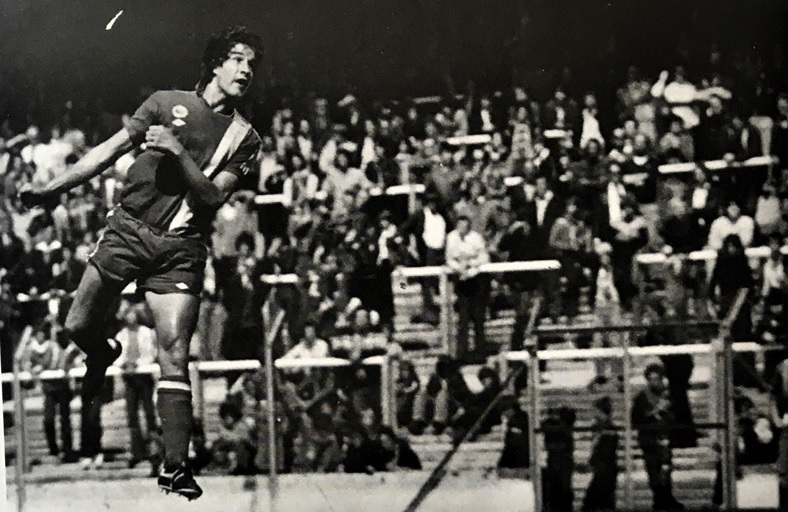
Dwyer scoring for Cardiff City in 1978
In his autobiography he stated: "All I cared about was football". At 14 yrs of age he got into the Cardiff Schools team and was selected for Wales under 15 squad for the Victory Shield. One of his treasured memories is playing at Wembley and his pride at being selected to play for Wales was unbounded.
"Putting on the blue Cardiff shirt sent shivers down my spine," he said. Admitting he "wasn't the most skilful player of all time" he nevertheless made sure he always gave 100% for the jersey.
When he was 16 he got a job for two years on the ground staff of Cardiff City and at 18 he was offered a professional contract for two years at £20 per week. So in 1971 he became a professional footballer, making his first team debut in 1972 against Leyton Orient Even when he was a pro he continued to play baseball for Grange Catholics in the summer.
When Phil describes his youth in Grangetown some of his memories will resound with all of us i.e. about the Black and White Cafe and trying to get into the Ninian Cinema without paying and trying to get into the Ninian Park Football ground without paying. Also his evocative descriptions of his home without central heating and his Dad who kept pigeons in the back garden in common with so many Grangetown people.
Phil's achievements were many and are well documented - including a record 575 games over 16 years for the Bluebirds. Will that ever be beaten? His time at Ninian Park included two promotions from Division Three and he earned 10 Wales caps in 1978 and 1979.After ending his career at Rochdale he became a police officer.
His autobiography Mr. Cardiff City The autobiography of Phil “Joe” Dwyer was published 2011, by Fort Publishing Limited of Ayr amd can still be bought on Amazon. Thanks to them for permission to use photographs and quotes from this book. It is also available to borrow at local libraries.
The Grangetown stadium which might have hosted Cardiff City's rival....
Did you know there once used to be a horse racing and athletics stadium in Grangetown?
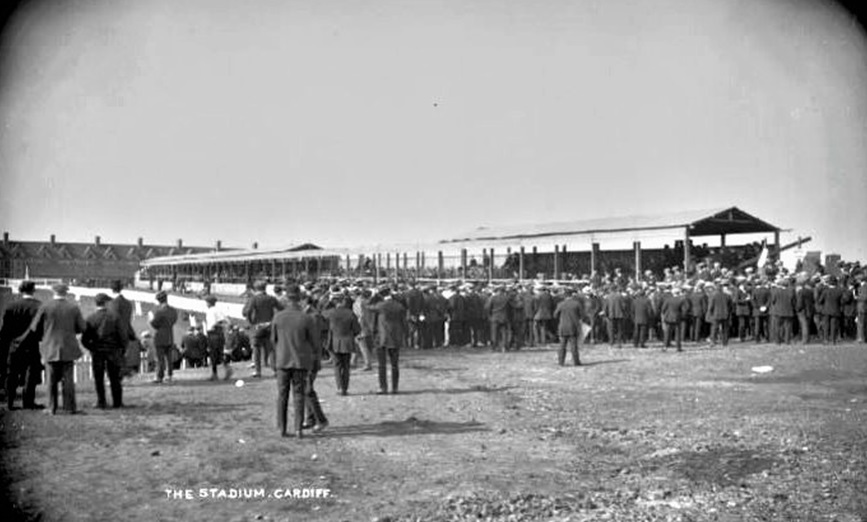
A photo of the stadium in 1905. People's Collection/National Library of Wales.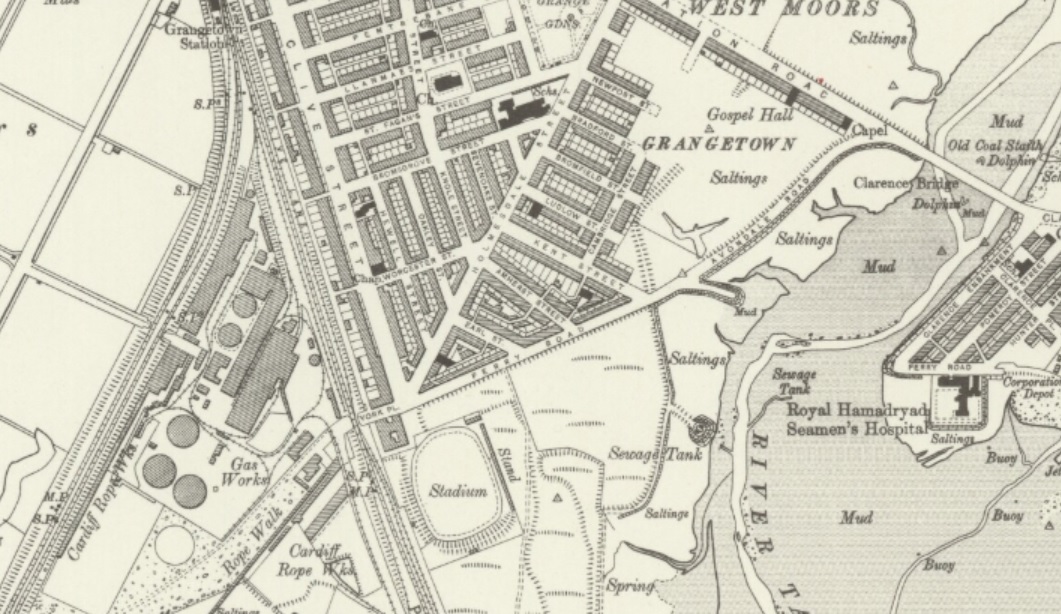

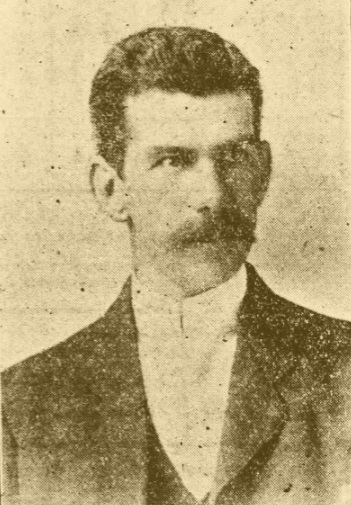
Harry Duggan was a sporting entrepreneur
GROWING UP IN THE 1950s - JAM TOMORROW
AND REAL MADRID
I am 14 years younger than my brother
Jack, and the youngest of six children, with three brothers and two sisters.
I was born in 1947, at 81 South Clive Street. Living in Grangetown in those
days was still quite hard .Most of the families were large and hand-me-down
clothes from siblings were common place. The large majority of boys my age
were in the same situation (underwear was something I didn’t possess). Other
memories of clothes were the trouser pockets always having holes in them
and spending your time fishing things out of the lining. Shoes were hand-me-down
if possible, repaired in Len's Shoe Shop in Holmesdale Street, or made do
with cardboard and string.
I would like to recall some local sports
teams and maybe get some input from others with the same fond memories?
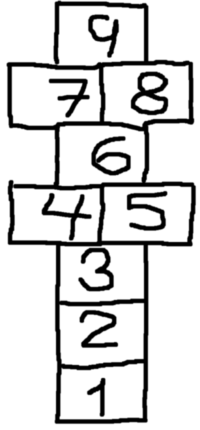 SWING THAT TIGER Played mainly by boys. A line of boys would stand in
a row holding hands. The first boy would then begin to turn followed by the
others getting faster and faster. Eventually the boy on the end or the last
two would be off the ground swinging in a circle.
SWING THAT TIGER Played mainly by boys. A line of boys would stand in
a row holding hands. The first boy would then begin to turn followed by the
others getting faster and faster. Eventually the boy on the end or the last
two would be off the ground swinging in a circle.